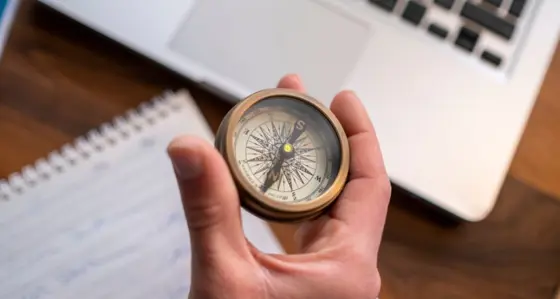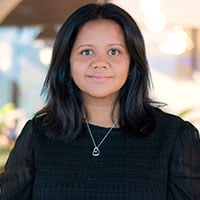Mansi Hello and welcome to the next episode of our COO podcast, The Rise of the COO, bringing together chief operating officers to tackle pressing topics that matter to them in today's world. My name is Mansi Patel. I'm our Capabilities Sector Leader and COO Network Sponsor at Baringa. In today's episode, we talk about shaping the future of the firm - how COO roles are evolving from operator to orchestrator and the challenges and opportunities that brings. I'm so pleased to welcome our guest speaker today, Tom Amies-Cull, Chief Operating Officer at Kinesso. Tom will share some invaluable leadership advice for COOs on how to be that connective tissue between strategy and execution in order to drive both operational excellence and future-focused innovation. I'm absolutely delighted to have you with us here today, Tom, welcome.
Tom Thank you for having me, really excited to be here.
Mansi Now Tom, I've had the pleasure of working with you over the last couple of years and at different companies as well. It perhaps would be lovely for this audience who are listening today to hear a bit about your career journey and how some of your roles have changed over time as well?
Tom Sure, so a really unconventional start to an advertising career. After finishing school, I got a place to go to university which I deferred, and decided to go and work for our local Tesco - in the store. Something about working part of a team, earning money was really alluring. I then went to work for head office in a support role, which was down the road from where I used to live, and then laterally moved into London and moved into a digital publishing admin job, which is where I fell into marketing advertising. I then moved into the agency world, which was where I've been ever since. My early roles in advertising were running digital marketing campaigns for clients, running accounts and moving up through management roles to a point where I ran iProspect, one of Dentsu's digital performance agencies - all of the operations outside of London - responsible for growth, product, sales and everything. And that was where I had an inflection point moving into my first COO role. I spotted an opportunity to integrate our UK offices, was probably a little bit annoying to our CEO at the time and he said, ‘OK, you go and fix it’. So they created a COO role which I took and integrated our seven operations in the UK and Ireland. And then I took on more agencies across the group and then moved into a global role. And then more recently, I've moved into Kinesso, which is part of Interpublic, another one of the big global holding companies where I'm global COO for our operations there.
Mansi Great. So, tell us a little bit about Kinesso.
Tom Sure, so Kinesso is Interpublic’s data, tech and performance arm. We provide services such as addressable media, analytics, operation, and transformation services for a number of the Interpublic agencies. We also operate all of our global capability centres. So that's our integrated set of network hubs in locations such as India, the Philippines, Poland, and they support our in-market teams across a broad range of media and data services, plus some engineering resources and needs.
Mansi It seems like you're driving, through what you've described, Tom, some great cross-functional collaboration within Kinesso. How do you measure the success of it?
Tom So it starts with leaders and one of the tactics I use is leadership peer assessments. So I, for all of my leaders, I have a common objective they all have where they are all tasked with an objective to support each other, helping them achieve their goals. So we then measure that on a quarterly basis. We have a survey that all of our leaders complete, and they measure two things; one is how supported do they feel by others and the other is how much they feel they support their peers. We aggregate those results, and what it gives you is a map of each of the different functions and the different leaders in my team, how well are they supporting other people to achieve their goals, and how well do they get perceived as supporting others. And so you can then use that result at a macro level to have a conversation with the team, and then you can pick up any particular mismatches in people who aren't leaning in to support others in one-to-one conversations.
Mansi Brilliant virtuous cycle that you've created there as well. How does it land with them?
Tom It lands really well. I think it takes some courage for people to answer those questions honestly. You have to do it a few cycles because no one wants to report that their peers aren't supporting them. It's not human nature. But if you encourage honest reporting, if you encourage an open discussion, then after you've done it for a few circles, you start to have some more meaningful conversations and people start to realize that you can use those results to drive shifts in behavior. So after you run it for few times, teams start getting more honest and then you can start doing more of those results.
Mansi It's insightful, isn't it, how when you get teams to embrace some of that discomfort, the power of what gets unlocked and enables them to become that higher performing team emerges quite quickly.
Tom Yeah, it's human nature to be nice. And everyone wants to work in a collaborative, comfortable team, which is what we should strive for. Harmony in a team is great, but we shouldn't think that harmony doesn't mean you can't have some difficult conversations. And if you do that in an environment where you feel trusted, supported, empowered, et cetera, then people start to realize that having the right conversation at the right time means that everyone can go further and faster and better.
Mansi And it'd be remiss of me not to share, obviously, in the Baringa world we talk about being kind and not nice, because actually that's about really ensuring people develop in some of those areas and understand those differences. Great. Thank you for sharing that, Tom. And given your time at Dentsu, where I guess you effectively helped create that COO role for the opportunity that you saw, I know from our prior conversations outside of this podcast, all of the different changes you've seen throughout the course of your career and that real evolution from being an operator in a business to having to be an orchestrator. Most notably because of the organizations you were working in being so global in nature, often matrixed in nature as well. So really making sure that orchestration is a core part of what you do. Now, our observation is modern COOs have genuinely transcended from day-to-day operations to help drive that organizational transformation. Tell me a little bit about what strategic orchestration looks like in practice within your role, your remit, and within Kinesso.
Tom Yes, so strategic orchestration for me, without sounding too clichéd, is about creating synergy and harmony into the system, moving beyond some of the efficiencies that we're looking to create in more traditional roles. So it's moving beyond functional integration and coordination of change, building a system based on behaviors, common goals that gets everyone moving in the same direction, and that can adapt and respond in a world where by transformation it's becoming a constant. I think about it across three dimensions; there's orchestration within the firm - you know, across Geos, capabilities. There's orchestration of your firm in the ecosystem and the partners and the clients you operate in. And then I think the other dimension, which is maybe something that makes it a bit more strategic is thinking about the time dimension, which is orchestrating the activities you're doing now with what needs to be done in the future to keep your business relevant. Because we're operating in a world with a hyper-fast pace of change. We thought the number of platforms, partners and data sets was already changing really quickly. If you think about the introduction of AI over the last few years, that pace of changes has radically become faster. And so we have to make sure that the future and the current stay connected. So if you look at my role, I manage both our operational excellence and transformation teams and a number of our service delivery teams so that we can try and reduce the difference between the run and change teams.
Mansi And Tom, in what you described there in those three different roles or focus areas, is there an example that you might bring to life for our listening audience today?
Tom Yeah, a lot of the work inevitably revolves around some of our technology. And so we have to think about how our processes our teams follow today are using the tools and the platforms that we have built today. But equally, you know, with the rise of AI, we have to make sure that we are thinking about what those platforms look like in the future and the way that our teams need to work. And so, we're working with our addressable analytics teams, for clients today. We have scopes that have been live for those clients over the last year or two. We've got to deliver those services. We've also got to think about how do we change those scopes with our clients, using the new technologies and new services that we can offer for them. So we've got to do that dual running of doing something for them today, but also changing something for the in the near future.
Mansi Great. Thank you. Now recognizing the need both to be a brilliant operator of the business as well as an orchestrator, I know there's a pivotal role for you as a COO to play as an organizational connector. Someone that really is able to drive collaboration and break down the silos, particularly in large global matrixed organizations like the one that you work in. How do you connect different business units within Kinesso? What strategies work best for breaking down any organizational silos, which I know you and I both know exist in organizations of this size and scale?
Tom Yeah, so as you said, in a complex organization, it's difficult. So I would say it has to be purposeful. You can't leave these things to chance.
Mansi Love that word.
Tom So at a macro level, things we do are the things you'd expect. So we have regular executive meetings, senior leadership sessions, each have a purpose, cadence, agreed inputs and outputs. My preference is to have more frequent, but short sessions so you can keep momentum and quickly get to issues and solve. We then encourage a number of cross-functional forums to drive collaboration around specific initiatives. That could be a new product launch, that could be a transformation workstream. And for those, you've got a variation of how we run those. And we try to empower the leaders of those different forums to think about what works best for those, but bringing in people from different parts of the organization to collaborate around a specific initiative or topic where they might come from different functions. Also more tactically, some of the basics you might want to think about: setting collaboration objectives - so put objectives for leaders to support each other explicitly. Rotate people around different teams and functions - I've got people running our global capability centers and transformation teams that have come from client teams. I've got people in client teams who are brought in for more operational excellence background to bring different perspectives and that breaks down silos. The other thing which I bang on about a lot is celebrating the Reds. So when you're coming together in those forums, really as a leader, encourage your teams to bring problems, encourage your team when they've got a state of support to put on a Red if it's not working. And that takes a bit of courage and a bit coaching for your team sometimes to start. But what I found is when you do that and you get people coming to their peers with an issue or a problem, then they start to solve that amongst themselves and that starts to help break down organizational barriers as well.
Mansi I love that, and I love you've described both the frames and techniques and the mechanisms but then how to get the right conversation in the room which I've seen you do first-hand as well. Now, Tom, I view you as someone who is very much about the team, tell this audience a little bit about how you maintain the human connections within your role that also foster and help drive collaboration?
Tom Yeah, and it's hard for sure, right? I think in a global organization where we have a lot of remote workers and people in different countries, it's hard when you're remote or in a different place, you don't get those micro moments. You don't get it when you walk into a meeting, you don't get a micro moment when you have a cup of tea, or picking up on body language in the room, or, you know, able to grab someone after a difficult meeting. So, it's hard. And I think if you're leading transformation and change in a complex organization, you're asking people to do things differently. And if you're asking people to do things differently, you need trust. So those human collections are really important. You have to be intentional for the things that used to be natural when you're in person. So practical things you can do, you know, the thing I love, our GCC team, where we've got people around the world, we do the randomized ‘cup of tea generator’. So everyone's name goes into a generator every month, and people get paired up to go and have a virtual cup of tea. Very small, tactical thing you can do. Make sure you're creating time and space in meetings to have personal conversations. Signpost the right tools - there's so many technologies that people can use, so help people understand what they can use. And then as a leader, role model it! Open up. Sometimes it doesn't feel natural for all leaders, but if you're dealing with a virtual workforce, then people really value, in my experience, you opening up and taking time to go deep into the organization and have some personal conversations, just to create that connection. And you often hear some very useful feedback from the frontline. With all that said, I think where you can, encourage some real-life connection moments, it's hard, but if you can bring together teams around a particular purpose or event, then that I think also goes a huge way to driving collaboration. I just came back from a week in New York with my leadership team. We had a couple of days of workshops. We went deep into some issues. We looked at our OKRs for the rest of the year and also ran some development sessions for us as a leadership team so we can continue learning and developing.
Mansi Love that and just because some of what you've touched on is how to stay connected particularly across oceans but also when people increasingly have moved to working remotely as well. I guess the future of work involves AI agents a human digital workforce in combination and COOs are becoming the core or primary architects of the human AI collaborative workplace and I'd love to hear a little bit, Tom, just about how Kinesso is preparing For the AI agent integration or agentic AI within both media and marketing operations.
Tom Absolutely, it's a massive focus, as you can imagine. And I would probably describe that as - we have maybe three pathways that we're working towards. So the first is we have existing tools. So we've got a platform called Interact that our teams have been using for years to orchestrate workflow and to go deep into certain processes. That exists today. We're deploying AI into that tool to help make that tool faster, better, quicker, to help some of the workflows be smarter. So, first thing we're doing is looking at deploying AI into things that we already do, tools that we already have to make them better. The second thing we are doing is democratizing AI to all of our agency teams. So within Interact, our platform, we have a thing called AI Console, which is a sandbox where anybody in the entire organization can go in, use large language models and we signpost people to which model is the best one, the type of work they want to do. And we've got agent builders in there, you can share agents with other members of your team. And so we're trying to democratize the ability for people to use AI on the front line. What we also find from that, which is why it's so exciting, is that it creates a feedback loop because people on the frontline are innovating. You can go and find something they've done, take that back to the center, scale it and push it out. And then the third thing we're doing is more radically thinking about the work that we do, full stop. So how does work get done in a world whereby we have a more agentic future? And that doesn't require just a technology conversation - that requires a conversation about the relationships we have with our clients. It requires a conversion about the commercial models we have, moving away from just human-based remuneration models to more outcomes-based, and thinking about human technology equivalent kind of conversations and the people strategies you have. So that's a far more holistic piece that we have teams of people thinking about as well as the here and now.
Mansi You are obviously in the world of marketing, media, how do you make sure that implementing these innovations doesn't kill human creativity?
Tom A great question and a huge topic. It's a bit of a cliche, but I genuinely believe if teams lean in to use AI, then that can help accelerate and help them be more creative. It shouldn't be a takeaway question. They should be able to have more insights. They should able to do faster testing. They've got access to almost limitless inspiration. It's totally on leadership to help upskill and re-skill those teams so they can use AI, and to create a vision for what our future working patterns look like and our future skills and roles look like with AI. That said, we do need our workforce to want to change, too. And so I need our teams, and anybody working in a role, to want use AI. We can help them re-skill and to re-tool, but we've got to get them thinking about how do they work better and smarter with AI. Yes, there's going to be different ways of working, but they do need different mindsets that allow them to embrace this technology and to use that technology to unlock creativity.
Mansi And Tom, if AI agents become our digital teammates, what uniquely human capabilities become more valuable, not less?
Tom So think of what makes us human. Personally, I don't think that it's our innate ability to be in spreadsheets, to be coding. That's not a human attribute. Certainly not mine. It's about our ability to create relationships, to show empathy, to lead, nurture, care for others. And Sam Altman talks about this a lot. He's been obviously asked about what the future roles are. And he talks about that where we all see real value in human skills is things like our ability to ask questions. And this is the innate human desire to challenge, to smash together random ideas, to create something new. So those are the kind of behaviors and characteristics that are more human that I think we all value in this sort of the future world.
Mansi Certainly resonates with me. And whilst the role and remit of the COO will always have a drive towards efficiency and growth, what I hear commonly through all of the COOs I spend time with is their role in driving the culture of an organization. It'd be great just to hear a little bit, Tom, around the role you think the COOs plays in maintaining in your world agency culture.
Tom So I think for me, the way I approach it is it's about making some of it real. Connecting the dots between the strategy the exec team have created with you and making it real for your workforce. So translating the vision of the future that often exists but helping people get excited about it and critically helping them think about what they're doing today is driving that future vision. So connecting those dots and reducing that distance. I think the COO has a really important role to demonstrate and showcase how a culture of operational excellence enables growth and that growth benefits everyone. And if COOs can help role model and drive that culture, then people can understand why we're asking them to do what we're ask them to and start to have that growth flyball mindset.
Mansi There's so much that we're going to see evolve change over the coming years. So, lots for everyone to get excited about. So, Tom, how do you balance operational excellence with strategic innovation and risk?
Tom So it's about creating a connection between the two and treating them as part of one system, not an either or. You must have the foundations right. So, clients don't want to hear about innovation if campaigns are going out late. If you want a seat at the table to talk about growth, that's only earned if the basics are right. So operational excellence for me should be seen as the growth enabler, making the engines of the business run smoothly, reducing risk, building trust. Then you can unlock your organizational capacity and capability to innovate, deepen client relationships, and then uncover new value streams. So, it's the old growth flywheel of excel at the basics, drive efficacy, drive efficiency, create capacity to innovate, win new clients, launch new products, and then repeat the cycle.
Mansi Well, anyone who knows me knows I love a good flywheel. Brilliant. If it's okay, Tom, I might move to asking you a couple of questions just around your personal perspectives on the role of the COO. One of the questions I had for you was, what is the biggest myth about what COOs actually do versus what people think they do?
Tom So, I think a common one, maybe an easy answer, is I think a lot of people still think COOs sit in rooms with post-it notes and project plans.
Mansi Wait, you don't do that?
Tom I don't that. I don't always do that. And look at these big cost out initiatives. That's part of the role for sure. But I think certainly in complex organizations dealing with multifaceted, multidimensional transformations, actually a lot what COOs do is stakeholder engagement, it's managing the politics and the emotions and the stakeholders that we have in the organization. Albeit spreadsheets and post-it notes are really important.
Mansi Of course, we might never get away from them. What's been the most rewarding part of your role as COO so far?
Tom So without doubt the most rewarding piece I think is people. I love getting to work with so many different people in different parts of the organization around the world, understanding what makes people tick internally and externally, understanding cultures and how to get work done in an organization that's got so many diverse people, work styles and modes to it. The most challenging, I would say, would be, creating focus. I think there's so much to do, such rapid pace, so much is exciting, so I think one of the challenges I have to keep myself honest about and work with my team hard on is making sure we've got focus, so that the amount of change, the amount things we could do doesn't become overwhelming and you can actually get stuff done.
Mansi I think that's so important. One of the mantras I hold quite frequently in my mind is ‘remember what matters most’. That ‘what matters is most’ anchors me to keep the focus on certain things and I can just imagine with a broad remit that you've got having to keep going back to, ‘where's the focus, where is the direction’ you're setting’.
Tom Saying no is as important as saying yes.
Mansi Couldn’t agree more.
Tom And they're actually the harder conversations. So again, back to where do we spend time as COOs? A lot of that is having conversations with stakeholders who want stuff done, and you have to say, well maybe that isn't the right thing to be done at that time, because that will take our focus away from something else that's perhaps going to have more impact and more importance to the business.
Mansi Now what we've been talking about today certainly isn't the story of a COO sat in a room simply with post-it notes. We've talked today about the role around both operating the business as well as orchestrating within it. Being that key organisational connector, being a key individual in thinking about the future of work and the role of AI agents and what a human digital workforce looks like. So, do you feel the COO role is actually the new CEO training ground?
Tom Potentially, yes, and I think that there's lots of research out there at the moment saying that an increasing number of CEOs are coming from COO backgrounds. I think if that is a pathway that more COOs will be moving down, then I think it's great. I can understand perhaps a theory behind that is that COOs - because they're connected in so many different parts of the organization - they are exposed and have experience in different functions, not only how they work, but also how to get the most out of them together, which obviously is a key kind of thing that the CEO needs to do. I think if that's going to be a pathway, then COOs probably need to dial up on some of the ability to think maybe slightly longer range, so sort of multi-years versus multi-quarters, maybe dial up on some ability to have that sort of empathy and leadership quality, as well as managing down and operating.
Mansi Well, it ties very nicely to why we launched this podcast and titled it The Rise of the COO. What we've seen is the increasing remit role COOs are playing within their organizations and exactly as you described, that growing trend towards would they then forge the path to CEO. Now you talked about multi-year timeframes there, so it would be remiss of me not to ask you looking ahead what's one thing you're particularly excited to see evolve in the workplace over the next five to ten years?
Tom So I think a slightly more meta answer is redefining how work works. I am super optimistic about that, but equally I know it's a real friction point right now and there's a Microsoft report out, the Work Trend Index, where they talked about some brilliant stats around things like the amount of interruptions we get in a day. 275 interruptions in a day. How work is becoming increasingly last minute. How people are working more into their evenings and weekends. Work isn't working, to use an often quoted phrase. And I think what excites me, although it does require some purposeful thought, is how can we use some of this new technology around AI and agents to actually get control of work again? And I'm not necessarily talking about some deep process optimisation, I'm talking about how do we run meetings? How do we collaborate with each other? How do get work done in kind of globally connected organisations? I think that the power of technology that we are seeing come to market now to change and improve that is really exciting because not only does it mean we do better work for our clients, which is brilliant, but hopefully people get a better work-life balance because we know that in many sectors and certainly in our world, we want to have a better work-life balance for the people we employ.
Mansi Yes, now you've posed some really interesting and fundamental questions there that I think lots of our listening audience will probably want to hear answers for, so you might get a flood of questions from them yourself, Tom. I guess we've covered a lot of ground today, perhaps before we wrap up, is there one piece of advice or a key takeaway you'd like to leave our listeners with?
Tom Yes, absolutely. One piece of advice that has really stuck with me over the years is from Indra Nooyi, who's the former Pepsi Co CEO, and we were privileged enough to have her join one of our leadership sessions a few years ago. And she very eloquently put that the more senior a leader you become, the more of a student you have to be. And that really stuck me because I think in today's world, with so much change, so much innovation, it's unrealistic and not the right thing to expect that our leaders know everything. And actually, if our leaders let go to the concept that they should know everything and embrace the fact that you actually know very little and the skill though is asking the questions and learning from your teams, that should be something I think sets you off to success.
Mansi What's a lot of ground we've covered in this podcast today, Tom, starting with your entry into the working world, which I found so inspiring, and your path to that COO role, the time spent within Dentsu where in lots of ways you've seen that organization go through so many transformations and understood it through so many different dimensions, global matrix within certain teams, across many teams, and now your current role within Kinesso. And then just hearing you describe that experience of both orchestrating within some of those roles, as well as in parallel operating quite big teams across multiple geographies and across oceans has been fascinating for me. But also, just that point around holding onto and creating connection within these large organizations and your role as a COO in that. And quite frankly, your role as an individual and a human, because I've seen you do this so well with your teams. It's been brilliant to hear. I think it's also just fascinating to have heard the thoughts you shared around the future of the workplace. Thinking about agentic AI in media. I think lots of our listeners today will be quite interested in perhaps understanding some of the follow-ups to some of those examples you shared; the outcomes that you might generate from that as well. We're certainly in a very exciting future for both, I think, you as a COO, but for the organization and sector that you work in as well, so just a massive thank you for joining us today. It's been a pleasure to have you with us. Thank you.
Tom Thank you for having me. Great conversation.
Mansi And thank you to our listeners. Please do join the discussion, comment and tell us what you think. And if there is a specific topic you would like us to cover in a future episode, you can get in touch. We look forward to welcoming you back for our next episode.






